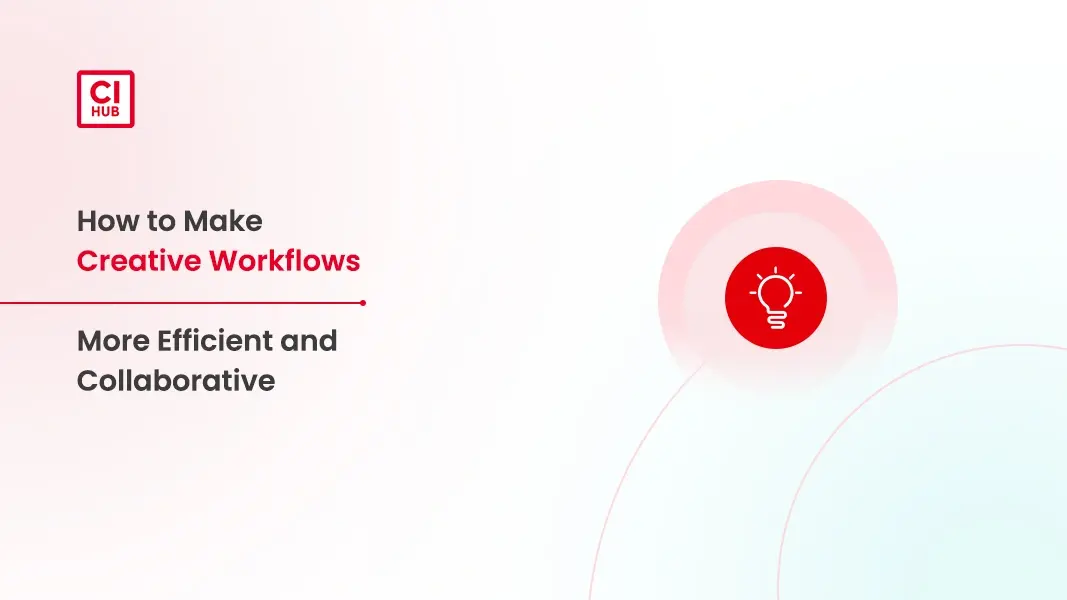Streamline Your Creative Workflows
Bring your DAM and daily tools together for faster, error-free content creation across your team.

October 02, 2025
TL;DR
Efficient creative workflows streamline collaboration, reduce bottlenecks, and maximize output for marketing and design teams. Using tools like DAM systems, workflow connectors, and project management platforms, teams can centralize assets, automate repetitive tasks, and improve visibility across projects. Case studies from CIDCOM and Ansira show how these integrations cut approval times, enhance team productivity, and maintain brand consistency globally. Implementing structured workflows ensures your team spends less time on admin and more on creative work.
Efficient creative workflows are essential for teams to meet deadlines and deliver high-quality content. In fact, one study found that 88% of creative teams face compliance issues due to chaotic or nonexistent review processes, underscoring the need for streamlined workflows.
Inefficiencies such as siloed tools, slow approvals, and disorganized asset management can hinder productivity and creativity. By optimizing creative workflows, teams can enhance collaboration, reduce delays, and deliver high-quality content more effectively. This guide explores strategies to transform your creative processes into a cohesive and efficient system.
In this blog, we will discuss:
What Are Creative Workflows?
The Foundations of an Efficient Creative Workflow
Step-by-Step Guide to Optimizing Your Creative Workflow
Essential Tools for Workflow Productivity
Practical Tips for Improving Creative Workflow Efficiency
Real-World Success Stories (Case Studies)
Take Creative Collaboration to the Next Level
Creative workflows are structured processes that guide a team from an initial idea to a finished creative output. They organize tasks such as brainstorming, designing, reviewing, and approving content. These workflows help teams stay efficient and accountable while collaborating on projects like ads, videos, and branded content.
Efficiency and collaboration in creative workflows are critical for teams to deliver high-quality work on time and within budget.
Creating an efficient creative workflow starts with building strong foundations. Teams need the right structure and tools to stay productive and collaborative.
Automation, templates, and clearly defined roles are essential starting points. Automating repetitive tasks reduces manual work and frees up time for creativity. Templates provide a consistent structure for projects, helping teams follow a standard process. Clear role definitions ensure everyone knows their responsibilities, which prevents confusion and keeps projects moving smoothly.
Centralized collaboration is key to keeping teams aligned. Using a Digital Asset Management (DAM) system, proofing tools, and connector solutions allows all team members to access the right files in one place. This streamlines feedback, keeps versions organized, and ensures everyone works with the most up-to-date assets. Centralized collaboration eliminates silos and makes cross-team communication faster and more efficient.
Teams often resist structured workflows because they worry that it will limit creativity. In reality, an optimized workflow doesn’t restrict ideas; it supports collaboration, keeps projects organized, and gives creatives more time to focus on what they do best.
Let’s explore how five key practices can help your creative team build workflows that drive efficiency without losing creativity.
Kicking off projects is often messy. A brief might come in through email, a chat message, or a phone call, and details get lost along the way. By using request forms and dashboards, you can capture all the essential information in one place: goals, timelines, audiences, and assets.
Best practices for request intake:
Once a request is approved, the next step is precise planning. Templates, clear timelines, and assigned responsibilities prevent overlaps and missed deadlines. Everyone knows their role and what’s expected.
Best practices for project planning:
Collaboration often breaks down when files are scattered across drives, folders, or email threads. A centralized platform supported by DAM systems and connectors, such as the CI HUB Connector, ensures that teams work with the latest versions of assets, eliminating duplicates and confusion.
Best practices for collaboration:

Approvals are notorious for slowing projects. Relying on lengthy email chains can lead to missed comments and repeated revisions. Automated notifications and proofing tools bring all feedback into one view.
Best practices for approvals:
Creative workflows aren’t static; they should evolve. Tracking KPIs like turnaround time, approval cycles, or revision counts helps teams see where bottlenecks exist. With AI insights and reporting dashboards, managers can continually refine processes.
Best practices for optimization:
Even the best-designed workflow needs the right tools to run smoothly. With creative teams handling multiple projects, having a connected tool stack is what turns a good process into a productive one.
A Digital Asset Management (DAM) system serves as the single source of truth for all brand files, whether it’s images, videos, or design templates. When paired with connectors like CI HUB, teams can access and use these assets directly inside their daily apps. No need to switch platforms, download, or re-upload.
How this helps:
Bring your DAM and daily tools together for faster, error-free content creation across your team.
Planning, tracking, and reviewing projects is much easier with project management and proofing tools. Project management platforms bring structure to the workflow by centralizing communication, task assignments, and approvals.
How this helps:
Small improvements in daily processes can make a big difference in how fast and effectively your creative team works. Here are some proven tips to keep your workflow smooth and productive:

Creative teams everywhere face common challenges, from slow approvals to managing global collaboration. These examples show how organizations used CI HUB to transform their workflows and achieve faster, smoother results.
CIDCOM, a leading Austrian agency, struggled to connect its DAM (CELUM) with Adobe InDesign. Designers lost time switching between systems, searching for assets, and dealing with outdated files.
In 2020, they integrated CI HUB Connector, enabling direct access to DAM assets inside InDesign. The intuitive interface simplified workflows, cut approval times, and improved campaign delivery speed. Today, CIDCOM’s creative team works more efficiently, with fewer delays and higher-quality outputs.
Learn more about how CIDCOM enhances creativity & efficiency with CI HUB.
Ansira, a global marketing services firm, manages thousands of assets for 500+ brands across 140 countries. Their design team faced version mismatches, disconnected workflows, and difficulty maintaining brand consistency.
By integrating Acquia DAM with Adobe InDesign via CI HUB Connector Professional, designers gained instant access to live, approved assets. This streamlined collaboration eliminated duplication and ensured consistent branding worldwide. The result: over 130,000 designs produced annually with a 98% satisfaction rating on turnaround times.
Learn more about how CI HUB helps Ansira offer creative efficiency and brand consistency.
Optimizing creative workflows and connecting teams with the right tools transforms the way organizations produce and manage content. From streamlining approvals to ensuring everyone works with the latest assets, a well-structured workflow boosts efficiency, collaboration, and output quality.
By integrating digital asset management, project management platforms, and workflow connectors, teams can focus on creativity rather than administrative tasks. Start building smarter workflows today to elevate collaboration and achieve faster, more consistent results across all your projects.
The 5 P's of creativity are Perception, Practice, Perseverance, Patience, and Passion. These are key elements that drive successful creative work. Together, they help one observe deeply, hone skills, persist through challenges, wait for ideas to mature, and stay motivated.
To ensure an efficient workflow, use visual tools like diagrams and flowcharts to clearly illustrate processes and enhance understanding. Train the team thoroughly so everyone knows their roles and responsibilities, which leads to better coordination and results.
The 7 steps in the creative process typically include: Preparation (gathering information and research), Investigation (analyzing and transforming ideas), Incubation (letting ideas develop subconsciously), Illumination (the moment of insight), Verification (evaluating the idea), and Implementation (putting the idea into action).
Collaboration enhances creativity by bringing diverse perspectives and skills together, fostering innovation through shared ideas. Regular brainstorming in a safe, judgment-free environment encourages open communication and fuels creative problem-solving, leading to more effective project development.

Article by
Michael Wilkinson
Marketing & Communications Consultant of CI HUB